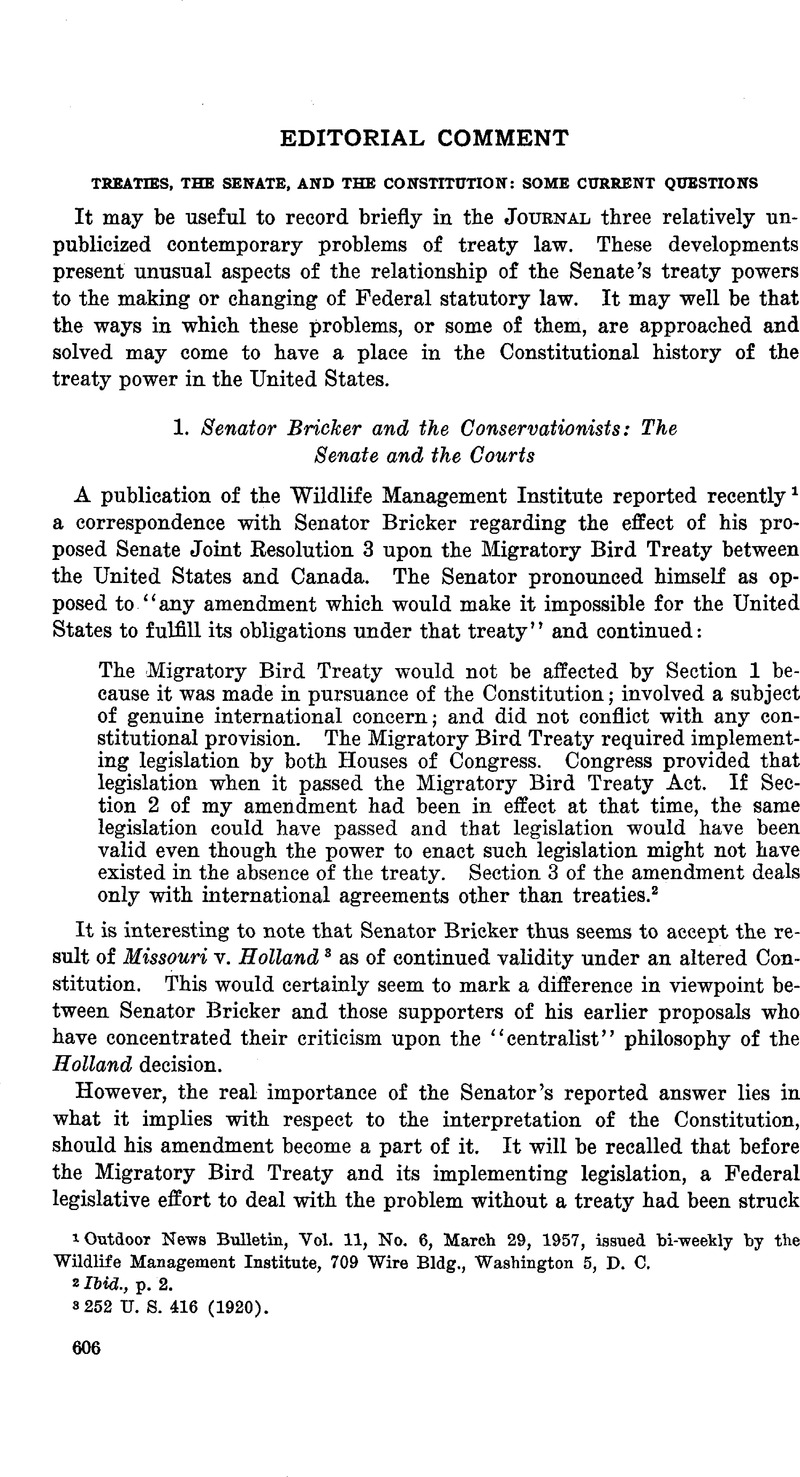No CrossRef data available.
Published online by Cambridge University Press: 28 March 2017

1 Outdoor News Bulletin, Vol. 11, No. 6, March 29, 1957, issued bi-weekly by the Wildlife Management Institute, 709 Wire Bldg., Washington 5, D. C.
2 Ibid., p. 2.
3 252 U. S. 416 (1920).
4 The opinion in Missouri v. Holland cites U. S. v. Shauver, 214 Fed. 154 (1914) and U. S. v. McCullagh, 221 Fed. 288 (1915), both as supported by the rationale of Greer v. Connecticut, 161 U. S. 519 (1895).
5 85th Cong., 1st Sess., introduced Jan. 7, 1957, read twice and referred to the Committee on the Judiciary. The operative portions of this latest version of the so-called “Brieker Amendment” read:
“Section 1. A provision of a treaty or other international agreement not made in pursuance of this Constitution shall have no force or effect. This section shall not apply to treaties made prior to the effective date of this Constitution.
“Section 2. A treaty or other international agreement shall have legislative effect within the United States as a law thereof only through legislation, except to the extent that the Senate shall provide affirmatively, in its resolution advising and consenting to a treaty, that the treaty shall have legislative effect.
“Section 3. An international agreement other than a treaty shall have legislative effect within the United States as a law thereof only through legislation valid in the absence of such an international agreement.”
[Section 4 deals with voting procedure in the Senate on advising and consenting to treaties.]
6 U. S. Constitution, Art. VI, 2nd par.
7 Charles Evans Hughes, as President of the American Society of International Law, 1929 Proceedings A.S.I.L. 194, as recorded in Bishop, International Law 83 (1953) ; see also part 2 of this editorial.
8 Senator Bricker’s reference to the fact that the Migratory Bird Treaty was not self-executing but was implemented may imply that Sec. 2 of his proposal, as well as Sec. 1, is to be applied retrospectively as well as prospectively. See the last sentence of Sec. 1 (note 5 above) and compare the quotation from the Senator’s statement to the conservationists, supra, p. 606.
9 Now part of the Federal Power Act, codified, 16 U.S.C. § 791a, et seq.
10 Treaty between the United States and Canada Concerning Uses of the Waters of the Niagara River, Feb. 27, 1950, 1 U.S.T. 694, 699.
11 JA 33–42, Nov. 30, 1956, dismissing application for license in project No. 2216.
12 Henkin, “The Treaty Makers and the Law Makers: The Niagara Reservation,” 56 Columbia Law Rev. 1151 (1956).
13 The parallel does not lose in interest when one reflects that very likely the Senators who sponsored the Niagara reservation do not see eye to eye with Senator Bricker on his proposals to change the treaty power.
14 Robertson v. General Electric Co., 32 F.2d 495 (4th Cir., 1929); Foster and Elam v. Neilson, 2 Peters 253 (1829); U.S. v. Percheman, 7 Peters 51 (1833).
15 Argento v. Horn, 241 F.2d 258 (6th Cir., 1957); digested below, p. 634.
16 Political treaties, on the one hand, and treaties for wartime conduct, boundary and private rights to lands on the other, 279 U.S. 231, 236 (1929).
17 Editorial, “Executive Agreements and Emanations from the Fifth Amendment,” 49 A. J. I. L. 362 (1955).Google Scholar
18 Cf. Arthur Krock, editorial on the proposed Senate “understanding” on the International Atomic Energy Agency Treaty, New York Times, June 18, 1957, p. 32, col. 5. Mr. Krock supports the use by the Senate of “understandings” that treaties be not self-executing as a simple and desirable alternative to Senator Bricker’s proposed amendment. But see the discussion, infra Part 3.